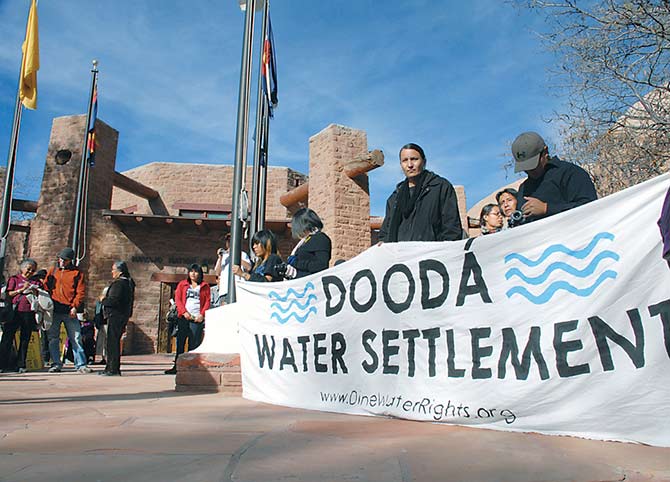Major water rights pacts signed, funded

(Times photo - Paul Natonabah)
The Concerned Citizens for Diné Water Rights from Flagstaff on Nov. 4 urged the Navajo Nation Council not to OK the Northeastern Arizona Indian Water Rights Settlement.
By Marley Shebala
Navajo Times
WINDOW ROCK, Dec. 31, 2010
It was the second of two major water pacts affected by significant action in 2010.
The vote took place amid controversy, as had the negotiations, with protestors saying the 300-page document was being rushed before most tribal members had a chance to digest its details.
President Joe Shirley Jr. met with the opponents and listened to their concerns, but on Nov. 18 signed the settlement agreement.
The agreement settles several lawsuits, including one between the Navajo Nation and Hopi Tribe over the Navajo Aquifer.
It recognizes the Navajos' right to use 31,000 acre-feet a year from the Lower Colorado River, 160,000 acre-feet from the Little Colorado River, and about 90,000 acre-feet from washes that cross Navajo and Hopi land. The two tribes can make unlimited withdrawals of groundwater from the Navajo and Coconino aquifers.
An acre-foot is enough water to cover an area the size of a football field with 12 inches of water, or 325,851 gallons.
The agreement authorizes three water projects to benefit Navajos in Arizona, and a problem with a fourth project in New Mexico is resolved.
The Western Navajo Pipeline would take water from Lake Powell - technically part of the Upper Colorado Basin but available to the Navajos under a special provision of the agreement. The $515 million pipeline would provide 10,906 AFY of drinking water to LeChee, Coppermine, Bodaway-Gap, Cameron and Tuba City. It would also transport 4,048 AFY to the Hopi villages.
The Leupp-Dilkon Regional Groundwater Project would cost $113 million and would provide about 4,800 AFY of C-aquifer water to Leupp, Birdsprings, Tolani Lake, Teesto, Dilkon, Indian Wells, Lower Greasewood and White Cone chapters.
The Ganado Regional Groundwater Project would provide 5,600 AFY of C-aquifer water to Ganado, Kinlichee, Jeddito, Cornfields, Steamboat, Klagetoh and Wide Ruins. It would cost $65 million.
The agreement also contains a guarantee to benefit the Navajo-Gallup Pipeline Project, providing for the delivery of 6,3411 AFY from the San Juan River.
A second landmark water rights agreement, settling claims to the San Juan River, also passed a milestone when Congress agreed to fund it.
It took six years for Congress to approve $720 million in federal funding for the construction and rehabilitation of water projects that include the Fruitland-Cambridge Irrigation Project, the Hogback-Cudei Irrigation Project and the Navajo-Gallup Pipeline.
All are part of the San Juan Navajo Water Rights settlement, approved by the Navajo Nation Council in 2004. The pact settles 20 years of litigation and recognizes the tribe's rights to 606,660 AFY from the San Juan River.
NEXT, No. 5: Where persuasion failed, the Council takes aim

